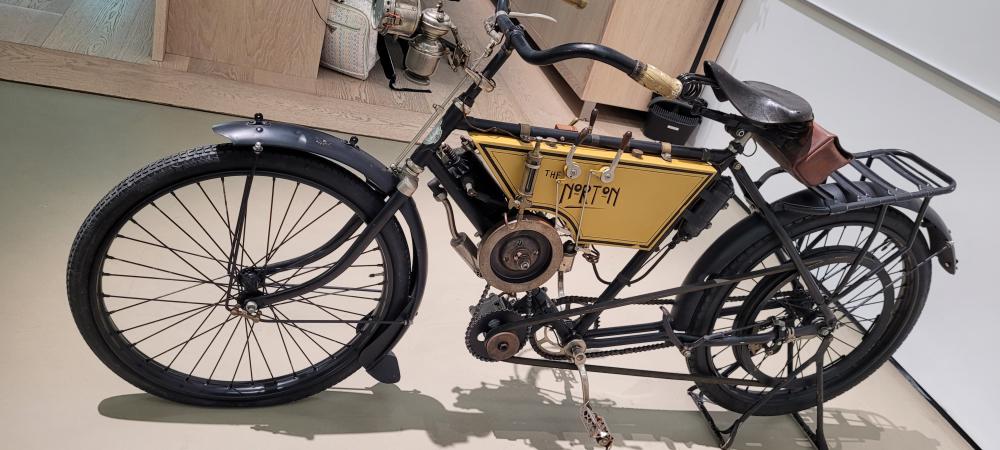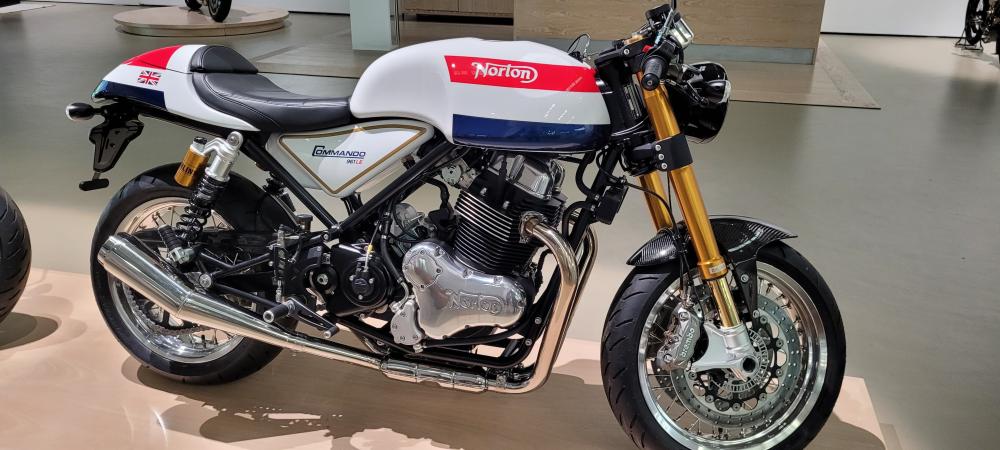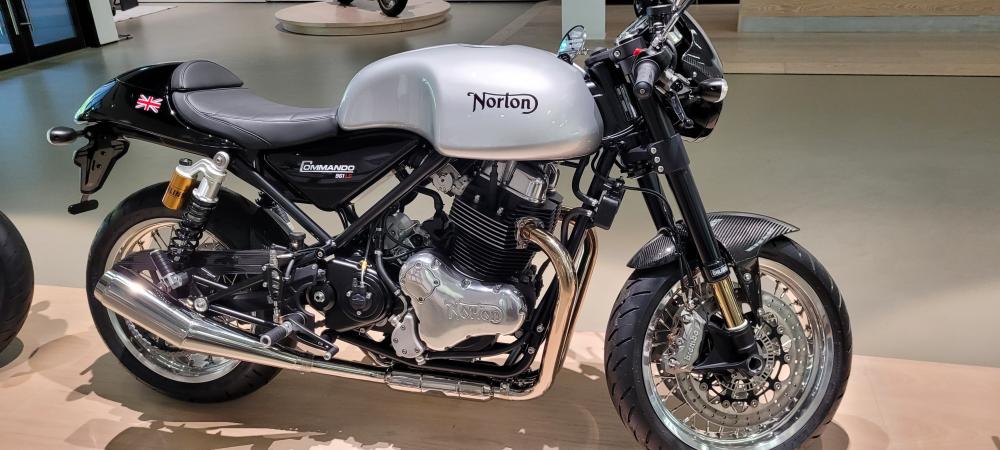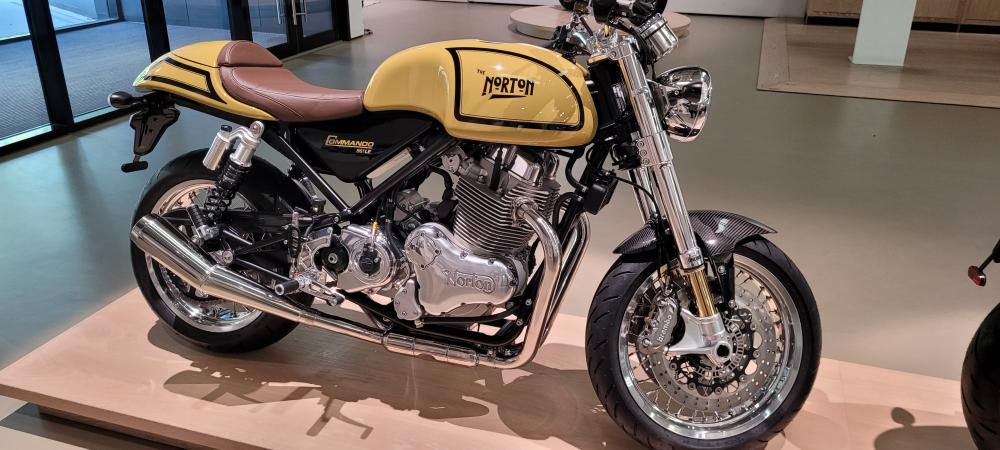1959 to 1970
In 1959, the ES2 and its smaller brother the Model 50, both of which had been in production for well over 25 years acquired the wideline Featherbed frame; though some cynics may say that the power output of the smaller machine hardly warranted the change. The 19S ceased production, it originally appeared in 1925 and was an ES2 with the engine enlarged to 596cc. The ES2 itself now sported coil ignition and alternator; a big order was received from Czechoslovakia for these machines, with further orders over the next two years promised. The Model 88 and Model 99 had redesigned camshafts with quietening ramps along with stellite tipped valve stems. There was also an option of a fully enclosed rear chaincase on all models, but it was not sealed at the front end, so dirt could still get in.
The next year, 1960, saw the introduction of the Slimline Featherbed onto the 88 and 99. De Luxe versions with rear end enclosure also came out. Gear ratios were also altered to close the gap between third and top. The change to the Slimline frame brought about a change of styling to both the seat and the petrol tank. The latter now had chromium plated elongated side embellishments with cast in 'Norton' name and stick-on rubber knee grips. Underneath the smart chrome however lurked a zinc alloy diecasting; as years pass this bubbles up hideously as most owners will testify; it is probably the next nearest thing to smallpox yet to appear on a motorcycle. The 350cc twin Navigator appeared, this being similar to the Jubilee but with a beefed up frame, Roadholder forks and Dominator brakes. This machine was also sold in standard and De Luxe guises; a standard Jubilee was also available. Late in the year, the 650cc Manxman was made for the export market. This had a striking polychromatic blue colour scheme, twin carbs and high handlebars. It is very rarely seen in its home country. On the race scene, Geoff Duke retired after a distinguished career; the leading riders on British short circuits were Mike Hailwood, Phil Read and Derek Minter, all on Nortons. The latter was almost unbeatable at Brands Hatch. Eric Oliver came out of retirement for one more go at the TT, but sustained a bad crash in practice and missed the race.
There was an unsuccessful attempt by AMC shareholders at the 1960 AGM to get rid of the group chairman, Donald Heather, and two other directors. None of these appeared to know very much about motorcycles. Heather is mainly remembered for once remarking to the effect that motorcyclists like nothing better than pulling their engines apart on Sunday afternoons. One of the others was actually a butcher by trade who had married the daughter of one of the Collier brothers. Norton sales were going quite well in 1960, a decent profit had been announced and MD Bert Hopwood was on the point of tying up a move to more modern premises not far from Bracebridge Street when the cheque for the purchase was removed from right under his nose so to speak in order for the funds to help AMC through a cash crisis. There were to be a few more of these over the years before AMC finally met the receiver. AMC were to depend more and more on the Norton side of their business; Norton was the one name with market charisma and was AMC's main hope for saving the slide to oblivion. This welcome aura was of course a spin off from years of extraordinary success in the racing field, which in reality had very little effect on the machines in general production, with the notable exception of the Featherbed frame of course.
Bert Hopwood left Norton during 1961, apparently fed up with battling against the increasingly inept and unbusinesslike parent AMC board. His replacement as MD was the company secretary, Alec Skinner. Distributorship of all the group's motorcycles in the big American market was now in the hands of Joe Berliner, a New Jersey based wheeler dealer who passed the bikes on to the shops and took care of warranty claims etc. This arrangement saved the factory a lot of hassle that Norton Villiers later ran into when they ran the import end themselves for the Commando. This gave Berliner a lot of pull in SE18 and the weak AMC board were led into selling export machines at rock bottom rates. Late in the year the 650cc became available on the home market in standard, De Luxe and Sports Special versions. The former two did not last long and are rarely seen, but the SS survived and quickly found favour with the production racing fraternity, the Syd Lawton entered machine being particularly successful in long distance events. The 88 and 99 both acquired an SS model with twin carbs, but not the more efficient downdraught head as fitted to the 650SS. The TT of 1961 was to be the last time a Norton Senior/Junior double win was performed; indeed, it was the last success in either race. Mike Hailwood, winner of the Senior, recorded the first and to date only 100mph plus race average on a single cylinder machine. Derek Minter started on the road ahead of Hailwood and just pipped him for the first single cylinder 100mph lap as a consequence. Australian, Tom Phillis, rode the works Domiracer to third place in the same race; a fine achievement on a pushrod machine. He also recorded an over the ton lap. The Domiracer was earmarked to eventually take over from the ageing Manx for racing purposes; the power output of the Phillis machine was already similar with the advantage of less overall weight. Doug Hele was the man responsible for Domiracer development, it was to be eight years before a pushrod bike lapped the Isle of Man more quickly, and then it took 750cc to do it. Definitely not with the TT in mind, one enthusiast was reported as building a 16H/Featherbed special. The ES2 was now using the slimline Featherbed frame; apart from the lightweights and the Model 50, it was standard on the whole Norton range.
The following year, 1962, started brightly enough as far as the buying public could see. Heather was finally evicted as AMC chairman and the already well stretched Dominator engine was enlarged once again to 750cc and sold as the Atlas on the export market. The power output was only marginally more than that provided by the 650SS, but it had more torque and quickly won a following across the Atlantic. There was a bit of a problem early on with frames breaking just above the front engine mountings, but this was cured by inverting the mounting lugs so that the tails were uppermost. The crankcase breather outlet was moved to the end of the camshaft on the drive side; this is an easy way to recognise the engine without peering at the numbers stamped on the crankcase. Most of the development work in ironing out the initial bugs was done after the move to Plumstead, although Doug Hele's original strictures on the maximum compression ratios to be used with the 750 engine were quickly ignored or forgotten. The 88SS was now fitted with a downdraught head and reverted to magneto ignition. But economics were now catching up with AMC and it was decided to close Bracebridge Street, the home of the Norton marque since WW1, and to move production south to Plumstead. Bracebridge Street has been described by somebody who knew it as a Victorian slum; it certainly had antiquated belt drive machinery to match the dismal, perhaps even Dickensian, surroundings. Among the last bikes to leave the Birmingham factory were a batch of police specification 650SS machines destined for Queensland, Australia; the first such order for this model from an overseas force. Only a handful of nearly 500 Norton employees made the move to London. Alec Skinner resigned as MD and Doug Hele departed to Triumph, where he quickly got to grips with their machine handling problems that were rather notorious at the time. The promising Domiracer project was shelved as business took a turn for the worse and was eventually sold off en-bloc to Paul Dunstall. He was a well known tuner of Norton twin engines and a purveyor of customising and hotting-up goodies for the machines. He was to keep the Norton name to the fore in production racing throughout the 60s.
The Model 99 was deleted from the range towards the end of 1962 and the following year was to see the demise of the standard 88, ES2 and Model 50. The dropping of the latter two brought to a close Norton's production of roadster singles after over 60 years, though AMC, typically AMC, did rebadge a couple of Matchless models some time later and tried to sell them as the ES2 Mk.2 and Model 50 Mk.2, an action derided by Norton and Matchless enthusiasts alike. The last Manx models were assembled in 1963, it is said from parts on the shelf from the previous year. By rights, the dominance of the OHC Norton engine should have waned in the early 40s had racing continued, but the post war ban on supercharging and then the Featherbed frame combined with the superb riding of Duke, Amm, Surtees and Oliver, not forgetting Joe Craig's development efforts, combined to keep it in the fore until the mid 50s by which time the foreign multis just had too much power. It had well earned its place in motorcycle history; happily some still thunder on in classic racing, so the legend is not dead yet. The entire AMC race shop was sold to Colin Seeley in 1966. He was mainly interested in the G50 and 7R stuff and consequently in 1969 sold the Norton parts and tooling to John Tickle. For a while he produced the Manx T3 (350cc) and T5 (500cc), using the late type Manx engine with AMC gearbox in a frame of his own design. Interesting sidelines in the autumn years of the OHC engine were Ray Petty's back to front cylinder head and Syd Mularney's four valve head, which once the bugs were sorted out was very successful on the racetrack. One addition to the Norton line up in 1963, the year of the axe, was the 400cc Electra. This was a Navigator with an extra 50cc and an electric starter, the first British motorcycle to be so equipped. Hard riders in Barbour jackets thought such a device somewhat effeminate; it could never catch on.
The 60s was the era of the cafe racer; many good Dominators were modified for this purpose, standard petrol tanks, handlebars, seats, footrests, exhaust systems etc. were all thrown off as too staid looking and replaced with something more racey. The De Luxe 99 frequently had the side panels removed and lugs ground off in the cause of fashion, which may help to explain its rarity today. There was also a craze for putting Triumph Bonneville engines into Featherbed frames in order to create Tritons, but as the 650SS engine was very similar in performance there was probably no real practical advantage. The Atlas was at last made available on the home market in 1964. The big twins all got 12V electrics, probably because all the Japanese bikes now flooding onto the market had them rather than any innate desire for technical progress by AMC. During 1963, Joe Berliner perceived a market in the U.S.A. for the lusty Atlas engine fitted into a Matchless competition frame for off road use. The outcome of this in 1964 was the Atlas Scrambler, first in the line of Norton/Matchless hybrids. Wider Roadholder forks were now put onto all models to permit the fitting of a wider tyre on machines destined for the U.S. market.
A heavier gauge rear chain was fitted to the big twins in 1965 and a bit unnecessarily perhaps, a clutch pushrod adjustment hole in the primary chaincase. Both the Navigator and Electra were discontinued, the latter after a very short life. A prototype 810cc parallel twin with chain drive OHC was under test. This was the P10. It never went into production however and the prototype is now on display at the National Motorcycle Museum, Birmingham.
The financial position of AMC was entering a critical phase as 1966 started. The Model 88SS was pruned from the range along with the Jubilee, leaving just the 650SS and Atlas to carry the Norton name, though in the U.S.A. the hybrid Atlas Scrambler was kept on sale. Towards the end of the year, AMC collapsed; Berliner tried to mount a rescue but this was unsuccessful and it finished up being sold to Manganese Bronze Holdings Ltd., the parent company of Villiers. This brought about the formation of Norton Villiers Ltd. Under the chairmanship of Dennis Poore. The new injection of capital and impetus as a result of the takeover led to the production of the Commando just one year later. Meanwhile, back in 1966, the 650SS and Atlas were being fitted with a double delivery six start oil pump worm, along with enlarged internal oilways and pressure feed to the rocker box. Left and right handed Amal Monobloc carbs were used; this simplified adjustment of the right side unit. Another modification was spigotless barrels, it was claimed in order to give longer cylinder head gasket life. This is open to query, lower cost of production could well have been the real reason.
Berliner now came up with another idea to combine hitherto uncombined Norton and Matchless parts. A prototype was built by Berliner's West coast associate, Bob Blair, and shipped to Plumstead for evaluation. The hybrid P11 was thus introduced early in 1967 and became quite successful in off road desert races. The prototype is still in England and has undergone complete restoration. The Atlas Scrambler was amended somewhat and named the N15CS. The two Featherbed machines now sported the new Amal Concentric carbs and a coil ignition system from Uncle Joe Lucas. Late in 1967 the P11 became the P11A and then the P11A Ranger in 1968, the last year of hybrid production. The Atlas and the 650SS were also terminated in 1968, but a new Featherbed 650 came out called the Mercury. This had a single carburettor, blue mudguards, oil tank and battery box, with a silver petrol tank. There was hump at the rear of the dual seat. It looked a cheaper to produce version of the 650SS, but with a similar retail price any financial benefit was to the factory rather than the customer. The Plumstead factory closed in 1969, with Mercury and Commando assembly moving to new premises at Andover.
February of the following year, 1970, saw the end of the Mercury, which by now was equipped with chrome mudguards and a rev counter. This brought to an end the Featherbed frame, exactly twenty years after it first appeared. It was without a doubt a quantum leap forward in motorcycle design and the benchmark by which all other frames are judged. The end of an era is surely a very appropriate point at which to suspend this narrative for another twelve months.
© Norton Owners Club 1988
Originally published in the Norton Owners Club Classic Calendar for 1988





